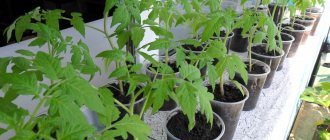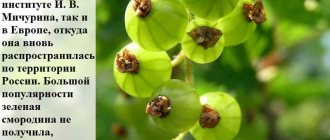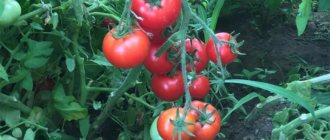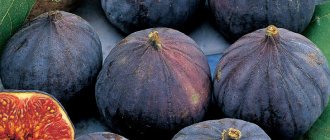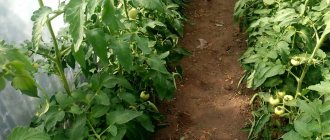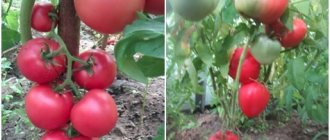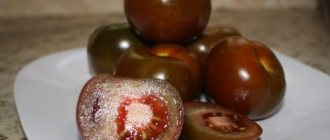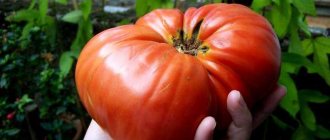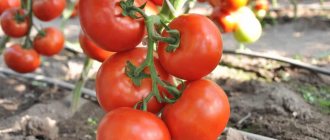General description of the variety
Pink figs were bred by domestic breeders. Included in the Russian register. This variety is grown not only here, but also abroad.
Features of Pink Fig
The main feature of the variety is its unusually shaped fruits. Due to the pronounced ribbing, it seems that they are divided into segments. This makes the tomato look like the exotic delicacy fig.
The variety is distinguished by large fruits. Individual specimens can reach a weight of 1 kg. The taste is also considered atypical for tomatoes. It is sweetish, with a fruity undertone.
Salad tomatoes are also used for making sauces and juices. These tomatoes are not suitable for canning as a whole due to their large size.
Pink figs are heat-loving varieties. To plant it, you need to choose the sunniest areas in the garden. It is also demanding on the composition of the soil.
Despite its whimsical nature, the variety is immune to most tomato diseases. Its resistance to viral infections is more pronounced than to fungal ones.
This is interesting! Gardeners say that the fruits that form in the lower part of the bush are larger than others on the plant.
Characteristics
The description of the Pink Fig will be interesting for both experienced and novice gardeners.
Characteristics of Pink Fig:
| Parameter | Indicators |
| Bush type | Indeterminate. The bush grows up to 3 m in height. The stems are thick, strong and branched. The leaves are green with a bluish bloom, lighter below and bright above. They have carved edges and pubescence. Fruits are formed on clusters of 3-5 pieces. |
| Growing method | They are grown mainly in greenhouses. In the southern regions, planting in open ground is possible. |
| Productivity | High. From one plant you can collect up to 7 kg of fruit per season. |
| Fruit | Large ones. On average, one fruit weighs 400 g. The largest reach a weight of 800-1000 g. The color is uniformly pink inside and out. The tomatoes are meaty but juicy. They have a rich sweet taste without sourness and a fruity aftertaste. The shape can be pear-shaped or rounded-flattened. The entire fruit has pronounced ribbing, similar to an accordion. Inside there is hypertrophied multi-chamber. Some cells are empty. |
| Transportability | High. The fruits have a thin but durable skin. They can be stored for up to a month. |
| Ripening time | Mid-early variety. The first fruits appear 100-110 days after sowing the seeds. Fruiting continues until the first frost. |
| Disease resistance | Has immunity to major viral and fungal infections. |
general information
The Red Fig tomato was bred in 2012, the originator is the seed company Gavrish (Russia).
The variety is suitable for growing in greenhouses and open beds. There are three varieties of this variety of tomatoes: red, yellow and pink fig tomato. They differ only in the color of the fruit, their size and slightly in taste. The yellow variety only appeared last year and has not yet become widespread.
Have questions?
Ask and receive useful advice from professional gardeners and experienced summer residents.>>
Pink Fig tomatoes and other varieties of the variety belong to the indeterminate type, that is, with unlimited growth. It must be limited by pinching the tops of the stems, otherwise the upper clusters will not have time to ripen, but the strength will be taken away from the plant. In open ground, it is recommended to do this at a height of 1.7-1.8 m, and in greenhouses it can be allowed to grow up to 2 meters.
Regular pinching is also required, the optimal formation of a tomato bush is 1 or 2 stems maximum. This way you can get an excellent harvest, and the plant will be well ventilated, which is the main prevention of diseases. Without shaping, the bush will have a crown up to 2 m in diameter.
High growth and an impressive harvest of tomatoes require a well-developed root system, so the plants should be planted at a distance from each other. Optimally – 3 bushes per square meter.
The Red and Pink Fig tomato varieties have a very impressive appearance of the bush: the heavily pubescent stems seem thick and bluish, the leaves are large, gray-green below, dark emerald above. The edges of the leaves are heavily indented and cover the fruits well from the scorching sun; there is no need to tear them off.
The stems are not very thick, they need support and garter, preferably under each brush or at least through one.
Fruit clusters begin to form above the 5th leaf, each most often containing 5 fruits of different sizes. Fig tomatoes are characterized by a high degree of plant self-pollination - even in a greenhouse, in the absence of insects, all flowers produce ovaries.
The yield of the variety is quite high - 7-8 kg of tomatoes per bush. In a greenhouse, per square meter of area you can get 25-27 kg of excellent tomatoes.
The variety belongs to the mid-early ripening period - the first fruits will become ripe in 100-110 days.
How to grow seedlings
The timing of sowing seeds depends on the region and method of growing tomatoes. When planting in a greenhouse, seeds are sown two weeks earlier.
In most cases, seeds are sown in March. In the northern regions of the country - in the first half of April.
Preparation of planting material
Before planting seeds, they must be prepared. Planting material is disinfected and soaked in a growth stimulator.
Seed preparation methods:
- Several types of compounds are used to disinfect seeds. For example, solutions of potassium permanganate (1 part potassium permanganate and 100 parts water), soda (0.5 tsp soda and 100 ml water), aloe (1 part aloe juice and 1 part water). The seeds are soaked in potassium permanganate for half an hour, and in aloe and soda for a day.
- After disinfection, the seeds are washed with running water and dried with a paper towel.
- To stimulate growth, pieces of cloth in which the seeds are wrapped are moistened with the solution. The fabric with the seeds is placed in a plate, covered with film and placed in a warm place for a day. Epin, Kornevin, Silk, Zircon, and Sodium Humate are used as growth stimulants.
Advice! Make sure the quality of the planting material. Check the expiration date of the seeds and soak them for half an hour in salted water. Floating seeds are considered unusable.
Selection of containers and soil
For sowing seeds, use special or homemade containers. They should be wide, but not deep.
Small 300 ml pots are suitable for picking.
The basis of the soil mixture for tomatoes is chernozem and humus. To lighten the composition, sand, sawdust or crushed coconut fiber are added to it. To improve the soil, it is mixed with ash and Fitosporin.
Purchased mixtures are also used. Select soil “for tomatoes and peppers.”
Advice! Experienced gardeners recommend using soil for seedlings taken from a greenhouse. It is believed that this will make it easier for tomatoes to take root after transplanting to a permanent location.
To disinfect the soil, it is calcined in the oven, watered with boiling water or a solution of potassium permanganate. The containers are soaked for half an hour in a strong solution of potassium permanganate or in boiling water.
Sowing seeds
In the prepared soil, make grooves at a distance of 2 cm from each other. Their depth should be from 1 to 2 cm. Seeds are placed in the recesses.
The seeds are sprinkled with earth on top. The soil is moistened using a spray bottle with warm water. The containers with seeds are covered with film or glass and placed in a warm place. At the right temperature (23-25 degrees), the seeds will germinate in 3-5 days.
Seedling care
The rules for caring for seedlings are quite simple. By following them, you will get healthy and strong plants:
- After the seeds germinate, the containers with tomatoes are placed in a well-lit place. The film is not removed for another 10 days. Regular ventilation will help prepare fragile plants. In March, the seedlings will not receive enough sunlight, so gardeners advise using fluorescent lamps.
- Before the seeds germinate, the soil is moistened with a spray bottle as it dries. If mold appears on the soil, the affected layer is removed, and the seeds with the remaining soil are watered with a weak solution of potassium permanganate.
- After sprouting and picking, water the tomatoes at the root so that water does not get on the greens. If the plants begin to wither and turn yellow, you need to reconsider the watering schedule. This problem occurs both with insufficient amount of liquid and with excessive watering.
- During the entire period of growing seedlings, they are fed three times. The first - two weeks after picking, the second - three weeks after the previous application of fertilizers, the third - three days before planting the tomatoes in a permanent place. Complex fertilizers and vermicompost are best suited for seedlings.
- Hardening off tomatoes will help them settle down in a permanent location. Such procedures begin two weeks before planting seedlings. To do this, the plants are taken out into the fresh air, gradually increasing the duration of the air baths.
Subtleties of care
At the stage of growth and development, the Red Fig variety needs careful care, which will ensure good yield and immunity against diseases.
- For irrigation, use settled water at room temperature. Up to 2 liters of water are poured under each bush. Moistening is carried out as the top layer of soil dries. During the fruiting period, plants especially need moisture, because if there is a lack of it, the tomatoes will grow small and not so juicy. During the fruiting phase, the bushes are watered every 5 days. After the procedure, the soil is loosened to avoid the formation of a crust on the surface. Weeds are also removed and rows are weeded.
- Fertilizers. Tomatoes need to be fed at least 3 times throughout the entire season. Superphosphate and potassium nitrate are added per m² - 1 tbsp each. l. on a bucket of water. 0.5 liters of working solution is poured under each plant. This feeding at the root is carried out two weeks before flowering and two weeks after it.
- To increase productivity, a solution of 10 g of boric acid, 2 liters of wood ash and 10 liters of water is added to the fruit set phase. 1 liter of nutrient liquid is poured under each bush.
- During the period of active ripening of vegetables, the bushes are fertilized with liquid sodium humate (1 tbsp.), superphosphate (2 tbsp.) per bucket of water. This composition improves the taste of tomatoes. The following foliar fertilizers are used: Kristalon, Master, Kemira or Sudarushka. Irrigation is carried out at the beginning of flowering and 10 days after the bushes have faded.
- Gartering is a mandatory procedure. After transplanting into open ground or a greenhouse, each bush is tied into a peg and continues to be fixed as the shoots grow. To prevent the stems from breaking off under the weight of the fruit, each cluster must be tied to a support. To obtain large fruits, the bushes are formed into 2 stems, removing excess shoots and shoots.
To prevent infection with diseases, tomato should be treated with Fitosporin.
Spraying the bushes and soil between the rows is carried out 3 times:
- two weeks after transplanting the seedlings;
- before flowering;
- two weeks after it.
Spraying with a decoction of celandine, wormwood, infusion of onion, garlic and marigold will help to avoid the appearance of parasites.
Twice treatment is required: 2 weeks after transplanting the seedlings into the ground and after the bushes flower.
At an advanced stage of the infection, bushes that have begun to bear fruit are removed from the site.
Tomato variety “Red Fig” Tomato Pink Fig THE BEST VARIETIES OF TOMATOES. THE MOST DELICIOUS TOMATOES - I RECOMMEND! TopSad. Topsad.
Growing tomatoes
The seedlings are transplanted to a permanent location after the soil has warmed up. In most regions this occurs in the second half of May or early June.
Planting tomatoes in a permanent place
First of all, you need to choose a suitable location for your tomato beds. It should be well lit and protected from the winds. You cannot use areas of the garden where nightshade crops have grown over the past three years.
They have been preparing the area for tomatoes since the fall. The beds are dug up and freed from plant debris. Organic fertilizers are added to the soil, for example, chicken droppings, mullein, potato peelings.
Be sure to check the acidity of the soil using litmus paper. If the indicators are elevated, alkali is added to the soil.
In the spring, before digging, mineral fertilizers, including phosphorus and potassium, are scattered over the beds. Then the beds are dug up and cleared of weed roots.
The holes are dug in rows, the distance between them is at least 60 cm. A gap of 50-60 cm is maintained between the holes. Per 1 sq. m there should be no more than 3-4 plants.
A tablespoon of stove ash is poured into each hole. The plants are removed from the pot and, together with a lump of earth, placed in a recess. Then the holes are covered with earth and watered with warm water.
Tomato care
Pink fig tomato bushes are formed into 1 or 2 stems. In the first case, the fruits will be larger and they will ripen faster, and in the second there will be more of them. In the afternoon, remove all excess shoots and yellowed leaves from the bottom of the stem.
Water the tomatoes as the soil dries out. Watering should be plentiful, but not frequent.
Pink figs are picky about soil composition. The plants are fed four times per season. Foliar fertilizing is also applied.
Mineral fertilizers alternate with organic ones. Purchased complex formulations are often used. Some gardeners prefer to prepare natural fertilizers themselves.
Fertilizer recipes:
- Organic mix. For 5 liters of water, take a glass of mullein and chicken droppings. The composition is thoroughly mixed and allowed to brew for 24 hours.
- Compost. To prepare it, pour a full bucket of fresh grass (without compacting it), add half a glass of ash and lime and 1 tbsp. l. carbonic acid dimide. The mixture is poured with water and allowed to brew for two days.
- Enriched herbal tincture. Finely chop the grass into a bucket and fill it with water. The mixture is allowed to ferment for 14 days, after which it is filtered and diluted with water in a ratio of 2/1. Add a glass of ash and mullein to the resulting composition.
- Fertilizer made from coffee grounds. The used coffee grounds are dried and placed under the roots of the plants. After this, they are watered with warm water.
- Yeast fertilizer. 2 packs of “live” yeast are poured into 5 liters of water. Add 4 tbsp to the composition. l sugar. When the mixture begins to rise, add another 2 liters of warm water.
Foliar feeding is applied every two weeks. Tomatoes are sprayed with the following compounds:
- add 1 tsp of urea to 10 liters of water;
- Add 1 teaspoon of urea, boric acid and copper sulfate to 10 liters of water.
Tomato “pink fig”: reviews, photos, yield
Fig tomatoes are a mid-season, high-yielding vegetable. Indeterminate bushes can reach up to 3 meters in height. The ground part of the plant forms a spreading crown with moderate formation of greenery. The pink fig tomato requires special attention in care. Reviews and photos (those who planted plants and cared for tomatoes post them on forums) will help you learn from the experience of caring for tomatoes. The bushes of the plant must be tied up, fastened to a special support.
It has high productivity. Up to 5 clusters of tomatoes ripen on one bush. From one bush you can collect up to 6 kg of selected fruits.
The pink fig tomato is large in size, with an average fruit weight of 500 grams. The shape of the tomatoes is flat-round with a ribbed surface, externally reminiscent of a fig.
The tomato has an interesting soft taste: sweet, with piquant fruity notes. Reviews characterize the pink fig tomato from the best side. Not everyone likes fussy plants, but it's worth the effort.
Breeders distinguish several types of fig tomatoes: there are red, pink and honey-yellow tomatoes, all similar in taste. It is this characteristic that makes the pink fig tomato so popular in cooking. The reviews (photo above) speak for themselves.
Mistakes in caring for tomatoes
Beginner gardeners often make mistakes when growing tomatoes.
Let's look at the most common of them:
- Incomplete removal of the stepson. If you do not cut off the stepson completely, the risk of infection of the plant will increase significantly.
- Taking steps at the wrong time. Tomatoes are planted in the morning or evening. Such procedures are not carried out on hot or cloudy days.
- Excessive watering. Waterlogged soil is an ideal environment for the development of fungi and viruses.
- Refusal to loosen the soil. After watering, a crust forms on the soil. If you do not loosen the soil, the crust will disrupt air exchange in the roots.
- Rare weeding. Weeds infect tomatoes with diseases and contribute to the spread of pests.
Diseases and pests
Tomato Pink fig rarely gets sick. Nevertheless, gardeners recommend preventing fungal damage to plants.
To avoid infection, the soil is disinfected before sowing seeds and picking seedlings. Plant seeds are disinfected.
Tomato bushes are sprayed with Fitosporin solution. This will protect the plants from fungal infection.
To protect against harmful insects, the bushes are sprayed with a decoction of chamomile and celandine. Colorado beetles, slugs and caterpillars are collected by hand.
Agricultural technology
During cultivation, you need to pay attention to several points:
- It is recommended to grow the Pink Fig tomato only in greenhouses. In open ground, the plant will bear fruit well only in warm regions of the country.
- As soon as the bush is formed, you need to install supports, since the height of the stems can reach 3 m.
- Clusters with fruits also need garter.
Sowing seeds
Before sowing seeds for seedlings, you need to prepare the ground. To do this, you need to take two parts of soil from the greenhouse, in which the bush will subsequently form, and mix it with one part of humus and river sand.
ADVICE! The soil in the greenhouse should also be “diluted” with sand and humus so that the plants adapt better during transplantation.
The seeds go on sale already processed, and therefore they are simply laid out in a container with soil, sprinkled on top and watered. It is best to cover the container with seeds with film or glass and place it in a warm, bright place with a temperature of 23 degrees.
Sowing is carried out on the 20th of March. The period is determined based on the fact that the sprouts are planted in the greenhouse fully formed at the age of 2 months.
FOR REFERENCE! Everyone is accustomed to soaking seeds before planting, but, as experience shows, stronger and more fruitful plants grow from dry seed material.
Growing seedlings
The “Pink Fig” variety is a moisture-loving plant, and therefore the soil with seeds must be constantly watered. The water temperature should not be below 20 degrees. When the first two true leaves are formed on the sprout, a pick is made. The seedlings take root in about 2 weeks, after which feeding can begin.
Special mineral complexes are used to fertilize seedlings. You can use potassium monophosphate at the rate of 1 tablespoon per bucket of water. Fertilizing is done in the evening, since the plant has a special biorhythm. It is at sunset that nutrition is absorbed best by “Pink Figs”.
Features of growing in a greenhouse and in open ground
When growing Pink Figs in a greenhouse, it is important to maintain an optimal level of humidity in the room. To do this, ventilate the tomatoes daily by opening the windows.
In a greenhouse, it is especially important to help plants pollinate. To do this, during the flowering period you need to gently shake the bushes.
On the street, even in the southern regions, for the first two weeks after picking tomatoes, they are covered with film. This reduces the likelihood of the death of a heat-loving variety due to night frosts.
Pest and disease control
Starting in June, it is recommended to carry out preventive spraying of bushes against fungal diseases. For this you can use the following drugs:
- "Fitosporin";
- "Ridomil Gold";
- "Hom."
Treatment should be done every 10-14 days, alternating products to avoid pathogens becoming addictive.
When growing crops in a greenhouse, whitefly damage is possible. This is facilitated by high humidity and elevated temperature. To destroy the pest, it is necessary to spray and water the bushes with Aktara. If it is impossible to use an insecticide during the period of fruit ripening, a decoction of celandine and onion peel should be used.
Farmer reviews
Feedback from farmers about the tomato is positive. Gardeners from different regions are happy to grow this variety on their plots.
Inga Krivyakina, Sochi: “I’ve been growing pink figs for two years now. I tried the yellow and red varieties of this series. The tomatoes are tasty, meaty and unusual. The largest fruit I managed to get weighed 760 g. I form bushes into 2 stems. From 1 sq. I’m collecting several buckets.”
Denis Zaitsev, Voronezh: “This year I tried to grow pink figs in a greenhouse for the first time. I fertilized regularly, but did not treat the plants with chemicals. The tomatoes didn't get sick. I'm happy with the harvest. I like both the taste and the unusual shape of the fruit. I want to try yellow figs.”
Advantages and disadvantages of the variety
Pink figs, like other varieties, have their strengths and weaknesses. Therefore, in order not to doubt when choosing, you should familiarize yourself with them in advance.
The fruits captivate with their unusual shape and excellent taste.
pros
- versatility of use;
- sweet taste;
- rich aroma;
- tomatoes do not crack when ripe;
- long fruiting;
- high percentage of seed germination;
- resistance to diseases and pests.
Minuses
- voids may form in tomatoes due to lack of moisture;
- increased demands on light and heat;
- the need for constant gartering and pinching;
- requires regular feeding.
Advice! Growing this species requires some experience, so it is not suitable for beginner gardeners.
Landing Features
The variety is characterized by high productivity
Seeds are sown in mid-March, so that the seedlings can then be planted in a greenhouse. For transplanting into open ground, sowing is done in mid-April.
After about two months, the young plants will be ready for transplanting.
Sowing
Before sowing in a tray, the seeds are disinfected in a purple solution of manganese, germinated for several days in a damp cloth and treated with a growth regulator.
The soil mixture is prepared from garden soil (calcined in the oven), peat and compost, and mineral fertilizers are added. Water the soil in the tray and make grooves 1-1.5 cm deep.
The seeds are laid out at a distance of 2-3 cm, sprinkled with earth, and pressed lightly. The tray is covered with film or glass and placed in a warm, dark place until the first shoots. The optimal temperature for seed germination is 23-26°C.
Seedling
It will take 5-6 days for sprouts to appear. With the first shoots, the tray is opened and watered with warm water. Lower the temperature to 16°C (for one week).
():
Reduce the temperature in the first days after germination so that the sprouts do not stretch, but primarily the root system develops.
The box is moved to a well-lit windowsill. When 2-3 true leaves appear, the seedlings are dropped into separate cups.
Water the plants once every 7-10 days, first with only water, and after a couple of weeks with a weak solution of manganese. Once a month, seedlings are fed by dissolving the fertilizer in water and combining the procedure with watering.
Two weeks before transplantation, the hardening process begins. On the first day, the pots are taken outside for 30 minutes, on the second day - for an hour, and the hardening time is gradually increased to one day of light.
Transfer
A week before planting tomatoes, the soil in the garden bed is fertilized with organic matter (compost, rotted manure), watered with manganese and dug up. Install supports for tying.
The holes are made at a distance of 50 cm (if it is planned to form 1 stem, you can retreat 40 cm).
Fertilizer (humus, superphosphate, ash, eggshells) is placed in each hole, the plant is placed together with a lump of earth and watered abundantly with warm water. The ground around the bush is slightly compacted and mulched with peat or black non-woven material.
Original fruits
Let's look at the features of the variety in more detail.
Unsurpassed taste
The name of the variety fully justifies itself. Figs seem to grow on a familiar plant of the nightshade family: these tomatoes resemble the fruits of a fig tree in taste.
The illusion of a fruit delicacy arises: pure sweetness and rich aroma. There is no trace of “tomato” sourness. Increased sugar content is observed even in those fruits that were picked green and ripened outside the bush.
Recognizable form
The shape of the fruit is memorable, but can be twofold. On some bushes, the tomatoes are pear-shaped, slightly reminiscent of the famous Truffle variety (Light Bulbs). By the way, figs have a similar shape. And on some bushes fruits grow round, strongly flattened from below and from the top, like in the picture from a packet of seeds from “Gavrish”. Both types are united by a clearly expressed uniform ribbing, almost an “accordion”, as if cutting along most of the surface.
The cut shows an atypical, hypertrophied multi-chambered fruit. Sometimes (especially if there is a lack of nutrition to the bush) small voids are observed inside, as for stuffing, but this happens rarely. In general, tomatoes do not look ugly - on the contrary, the tomatoes are quite smooth and very beautiful.
Appetizing coloring
In our minds, pink tomato fruits are strongly associated with high taste qualities. This is the favorite “tomato” color of many vegetable growers. Even the classic red tomato seems less attractive.
Decent size
Another important characteristic is the fullness of the fruit. The average weight ranges from 300 to 400 grams. With a lower limit of 200 grams, the maximum weight is four times greater. Tomatoes weighing 400–600 grams are not uncommon. Each brush carries 3-5 pieces of these “beauties”. One bush produces up to seven kilograms of “vegetable figs” per season.
The main harvest is spent on colorful fresh salads. Smaller fruits are suitable for pickling. It is also good to dry pink figs.
The tomato will taste like raisins. The juice (without adding salt) will also seem fruity, which is very useful for baby and dietary nutrition, even with increased stomach acidity.
Ripening time
Pink figs belong to the mid-early category. It features extremely long-term yield. It is superior to most other varieties in this regard. This is due to the focus on continuous growth.

